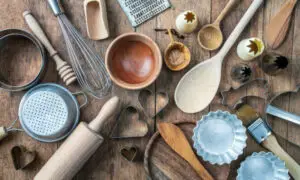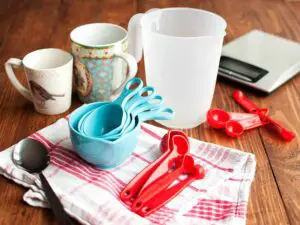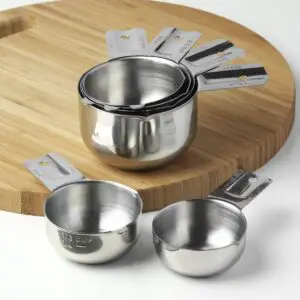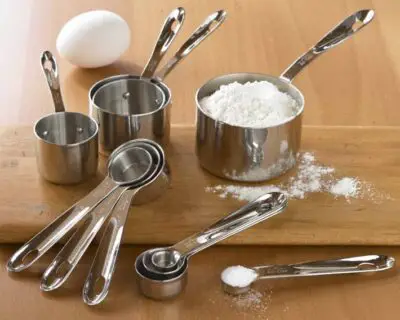Baking is a science, and precision is key to achieving delicious and consistent results. One of the most important factors in achieving this precision is the use of accurate measuring tools. In this blog post, we will take a closer look at the common measuring tools for baking and what makes them so essential to the baking process.
From cups and spoons to digital kitchen scales, we will explore the different options available and the benefits of using each one. Whether you are a beginner baker or a seasoned pro, having a good understanding of these measuring tools will help you take your baking skills to the next level.
What are the essential measuring tools for baking?

There are several essential measuring tools that every baker should have in their kitchen. These include:
- Measuring cups: Measuring cups are used to measure liquids and dry ingredients such as flour, sugar, and baking powder. They come in sets of different sizes, including 1/4 cup, 1/3 cup, 1/2 cup, and 1 cup.
- Measuring spoons: Measuring spoons are used to measure small amounts of ingredients such as spices, baking soda, and vanilla extract. They come in sets of different sizes, including 1/8 teaspoon, 1/4 teaspoon, 1/2 teaspoon, 1 teaspoon, and 1 tablespoon.
- Kitchen scale: A kitchen scale is a highly accurate tool used to measure ingredients by weight. This is especially useful when baking, as weight measurements are more precise than volume measurements.
- Mixing bowls: Mixing bowls come in a variety of sizes and materials and are used for mixing and preparing ingredients.
- Thermometer: A thermometer is used to measure the temperature of liquids, such as milk or water, or to check the internal temperature of baked goods.
By having these essential measuring tools in your kitchen, you can ensure that your baking is precise and consistent, leading to delicious and successful results every time.
What is the purpose of measuring tools in baking?
The purpose of measuring tools in baking is to ensure accurate and consistent measurements of ingredients. Baking is a science, and precision is key to achieving delicious and consistent results. The correct ratios of ingredients are essential for the chemical reactions that occur during baking to produce the desired texture, flavor, and appearance of baked goods.
For example, using too much or too little of an ingredient, such as baking powder or salt, can have a significant impact on the final product. Too much baking powder can result in a cake that is too dense and heavy, while too little can result in a cake that does not rise properly.
Measuring tools also allow bakers to repeat recipes with the same results, making it easier to recreate their favorite baked goods. By using measuring tools, bakers can be confident that they are using the correct amounts of ingredients, which helps to eliminate the guesswork and ensures success in the kitchen.
Overall, measuring tools are a crucial component of baking, as they help ensure that recipes are followed accurately, leading to consistent and delicious results every time.
What are the most common measuring tools used in baking?
The most common measuring tools used in baking are:
- Measuring cups: Measuring cups are used to measure liquids and dry ingredients such as flour, sugar, and baking powder. They come in sets of different sizes, including 1/4 cup, 1/3 cup, 1/2 cup, and 1 cup.
- Measuring spoons: Measuring spoons are used to measure small amounts of ingredients such as spices, baking soda, and vanilla extract. They come in sets of different sizes, including 1/8 teaspoon, 1/4 teaspoon, 1/2 teaspoon, 1 teaspoon, and 1 tablespoon.
- Kitchen scale: A kitchen scale is a highly accurate tool used to measure ingredients by weight. This is especially useful when baking, as weight measurements are more precise than volume measurements.
- Mixing bowls: Mixing bowls come in a variety of sizes and materials and are used for mixing and preparing ingredients.
- Thermometer: A thermometer is used to measure the temperature of liquids, such as milk or water, or to check the internal temperature of baked goods.
These measuring tools are commonly used in baking and provide bakers with the precision and consistency necessary for successful results in the kitchen.
How to choose the right measuring tools for baking?

Choosing the right measuring tools for baking is important for ensuring consistent and accurate results. Here are a few things to consider when selecting the best measuring tools for your kitchen:
- Accuracy: Look for measuring tools that are highly accurate and can be calibrated, such as a kitchen scale. This will help ensure that you are using the correct amounts of ingredients in your recipes.
- Ease of use: Choose measuring tools that are easy to use and read, such as measuring cups with clear markings and measuring spoons with a clear and readable font.
- Durability: Consider the material of the measuring tools and make sure they are durable and long-lasting. Stainless steel and plastic measuring tools are two common options that are both durable and easy to clean.
- Convenience: Select measuring tools that are convenient to use and store, such as stackable measuring cups and nesting measuring spoons.
- Versatility: Consider purchasing measuring tools that can be used for multiple tasks, such as a kitchen scale that also has a tare function to weigh multiple ingredients.
By taking these factors into consideration, you can choose the right measuring tools for your kitchen and take your baking to the next level. With accurate and consistent measurements, you’ll be able to achieve delicious results every time.
What is the difference between dry and liquid measuring tools in baking?
In baking, it’s important to differentiate between dry and liquid measuring tools, as they serve different purposes.
Dry measuring tools, such as measuring cups and measuring spoons, are used to measure dry ingredients such as flour, sugar, and baking powder. They are designed to be filled to the top and leveled off, as dry ingredients tend to settle and compress over time. This ensures that you get an accurate measurement of the dry ingredient, even if it’s been in your pantry for a while.
Liquid measuring tools, on the other hand, are designed to measure liquids such as milk, water, and oil. They usually have a spout for pouring and a handle for easy lifting, and the measurement is taken at the bottom of the meniscus, which is the curved surface of the liquid. This ensures that the liquid is measured accurately, regardless of the angle at which the measuring tool is held.
Overall, it’s important to use the right measuring tool for each type of ingredient in your baking recipes to ensure accuracy and consistent results. By using the proper tools, you’ll be able to achieve the right ratios of ingredients, which is essential for successful baking.
What is a kitchen scale and why is it important for baking?
A kitchen scale is a device used to measure ingredients by weight instead of volume. It’s an important tool for baking because weight measurements are more precise and consistent than volume measurements, especially when it comes to ingredients like flour.
For example, a cup of flour can weigh anywhere from 4 to 6 ounces, depending on how it’s packed. This can make a big difference in a recipe, as even a small difference in the amount of flour can affect the texture, flavor, and appearance of baked goods.
By using a kitchen scale, you can ensure that you are using the correct amount of ingredients, which helps to eliminate the guesswork and leads to consistent results in the kitchen.
Another benefit of using a kitchen scale is that it can save time and reduce the need for multiple measuring cups and spoons. Instead of having to measure out several ingredients individually, you can simply place a mixing bowl on the scale, reset the weight to zero, and add ingredients until you reach the desired weight.
Furthermore, a kitchen scale is a highly accurate and versatile measuring tool that is essential for precise and consistent results in baking. By using a kitchen scale, you can be confident that you are using the correct amounts of ingredients, which will lead to delicious and successful results every time.
What is a measuring cup and what are its different types?
A measuring cup is a kitchen tool used to measure the volume of liquids or dry ingredients, such as flour or sugar, in cooking and baking. There are several types of measuring cups, each designed for specific tasks:
- Liquid Measuring Cup: This type of measuring cup is typically made of clear glass or plastic and has a spout for easy pouring. It is calibrated in fluid ounces, milliliters, or cups and is often graduated in increments of 1/4, 1/3, or 1/2 cups. Liquid measuring cups are used to measure liquids such as milk, oil, and syrup.
- Dry Measuring Cup: This type of measuring cup is typically made of metal or plastic and is used to measure dry ingredients, such as flour or sugar. Dry measuring cups are usually sold in sets, with each cup having a different size ranging from 1/4 cup to 1 cup. The cups are designed to be filled to the top and then leveled off with a straight edge, such as a knife, for accurate measurement.
- Measuring Scoop: This type of measuring cup is typically made of metal or plastic and is used to measure out small amounts of ingredients, such as spices or baking powder. Measuring scoops come in a range of sizes, from 1/4 teaspoon to 1 tablespoon.
- Adjustable Measuring Cup: This type of measuring cup is designed to measure both liquids and dry ingredients. It is typically made of plastic and has an adjustable mechanism that allows you to measure a specific volume by sliding the cup to the desired level.
It’s important to note that using the correct type of measuring cup for the task at hand is important for getting accurate measurements and producing consistent results in cooking and baking.
What is a measuring spoon and what are its different sizes?

A measuring spoon is a small spoon used to measure small amounts of ingredients, particularly in cooking and baking. It is a helpful tool for ensuring accurate and consistent measurements, which is important for producing consistent results in recipes.
There are several common sizes of measuring spoons, which include:
- Teaspoon (tsp): This is the most commonly used size for measuring smaller quantities of ingredients. A teaspoon is typically equivalent to 5 milliliters (ml).
- Dessert Spoon or Tablespoon (tbsp): This size is used for larger quantities of ingredients and is equivalent to approximately 15 milliliters (ml).
- 1/4 teaspoon (1/4 tsp): This size is used for measuring smaller quantities of ingredients and is equivalent to 1.25 milliliters (ml).
- 1/2 teaspoon (1/2 tsp): This size is used for measuring small to medium quantities of ingredients and is equivalent to 2.5 milliliters (ml).
- 1/3 teaspoon (1/3 tsp): This size is used for measuring smaller quantities of ingredients and is equivalent to 1.67 milliliters (ml).
Measuring spoons can be made of metal, plastic, or other materials and are often sold in sets that include the most commonly used sizes. Like measuring cups, it is important to use the correct size of measuring spoon for the task at hand to ensure accurate measurements and consistent results in cooking and baking.
What is a measuring cylinder and how is it used in baking?

A measuring cylinder is a laboratory instrument used to measure the volume of a liquid. It consists of a cylindrical container with markings on the side that indicate the volume of liquid it contains. Measuring cylinders typically come in various sizes, with capacities ranging from a few milliliters to several liters.
In baking, a measuring cylinder is often used to measure the volume of liquid ingredients such as water, milk, or juice. This is important because baking is a science, and precise measurements of ingredients are crucial for achieving consistent results.
Using a measuring cylinder ensures that the same amount of liquid is added to the recipe each time it is made. This helps to ensure that the final product has the desired taste, texture, and appearance.
It is important to note that measuring cylinders should only be used to measure liquid ingredients and not dry ingredients, as the volume of dry ingredients can vary depending on how tightly they are packed into the cylinder. For measuring dry ingredients, it is recommended to use a set of measuring cups or a food scale.
What is a ruler and why is it used in baking?
A ruler is a flat, straight tool that is used to measure length or distance. It typically has markings on it, such as inches or centimeters, that make it possible to accurately measure the size of an object or the distance between two points.
In baking, a ruler is not a commonly used tool. However, it can be used to measure the size of baking pans or the length of dough when rolling it out. This can be particularly useful when a recipe calls for a specific size of pan or a specific length of the dough. Using a ruler can help ensure that the final product is the correct size and will fit in the pan or be the correct size for decorating or cutting.
For example, when making a cake, a ruler can be used to measure the height of the cake batter in the pan to ensure that it is not too thick or too thin. When making pastries, a ruler can be used to measure the length of the dough to ensure that it is the correct size for rolling or shaping.
Overall, while a ruler is not a necessary tool in baking, it can be useful for ensuring that certain dimensions are accurate and consistent. This can help to improve the final outcome of the baked goods and ensure that they are the correct size and shape.
What is a kitchen timer and why is it important in baking?
A kitchen timer is a device that is used to measure the amount of time that has passed. It is often used in cooking and baking to help ensure that ingredients are cooked or baked for the correct amount of time.
In baking, a kitchen timer is an important tool because the timing of various steps in a recipe can greatly affect the final outcome of the baked goods. For example, overbaking a cake can result in a dry texture, while underbaking it can result in a gooey center. Similarly, leaving bread dough to rise for too long can result in a doughy texture, while not leaving it to rise long enough can result in a dense, heavy loaf.
Using a kitchen timer helps to ensure that the baker is aware of the elapsed time and can make necessary adjustments, such as removing the baked goods from the oven or checking the dough to see if it has risen enough.
Timers can be set to count up or count down, and some models even have alarms that sound when the time is up. This makes it easy to multitask in the kitchen and keep track of multiple steps in a recipe at once.
Conclusion
Are you in search of common measuring tools for baking? Accurate measurement of ingredients is crucial in baking, as it helps to ensure consistent and predictable results. Common measuring tools for baking include measuring cups, a food scale, a measuring cylinder, a ruler, and a kitchen timer. Each of these tools serves a specific purpose and can help to improve the quality and accuracy of baked goods.


